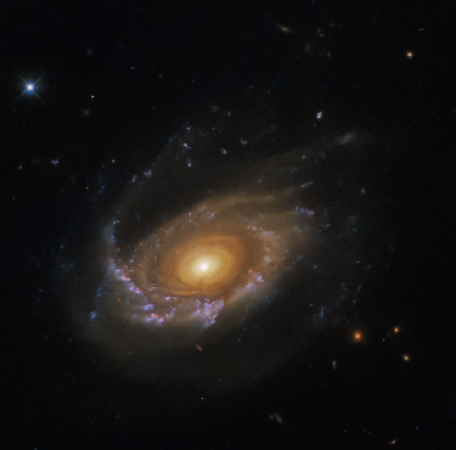
USA: The Hubble Space Telescope of NASA has captured an incredible picture of a jellyfish galaxy. The spiral galaxy's trailing tendrils and other details are revealed in the new image.
The galaxy, known as JW39, is located 900 million light-years from Earth in the constellation Coma Berenices. The galaxy appears calm, but it is actually suspended in a galaxy cluster that is bursting with hot plasma.
Recently, the Hubble Space Telescope celebrated its 33rd birthday. The European Space Agency (ESA) and NASA worked together to complete the mission. It has made more than 1.5 million observations so far and is the first significant optical telescope to be launched into space.
Also Read: NASA: The second lunar landing will be built by an aerospace team led by Blue Origin
The telescope has captured images of some of the most distant galaxies ever seen and helped scientists better understand how planets and galaxies form.
The JW39 jellyfish galaxy's bright core is clearly visible, and it is encircled by concentric rings of light and dark dust. The spiral arms of the galaxy are said to be "thick and puffy" with "grey dust." The galaxy's arms' dust is spiralling to the right. The glowing blue regions in the image—which represent areas of star formation—are immediately noticeable.
Also Read: Instagram intends to release a new text-based conversation app
Jellyfish galaxies like JW39 are known for their "trailing tendrils," which can be seen in the most recent Hubble image. Galaxies in galaxy clusters are frequently bent by the gravitational pull of larger neighbours, which can twist galaxies into a variety of bizarre and wonderful shapes, as opposed to their more isolated counterparts, ESA explained in a blog post.
A "ferociously hostile" galaxy cluster contains the JW39. The term "intracluster medium" refers to the "searingly hot plasma" that fills the space between galaxies in a cluster. Galaxies moving through this plasma, which is incredibly tenuous, feel it almost like swimmers swimming against a current, and this interaction can strip galaxies of their star-forming gas, according to ESA.
Also Read: WhatsApp is developing a new feature that will let iPhone users make stickers directly in the app
The phenomenon that causes JW39's trailing tendrils is known as "ram-pressure stripping," and it occurs when the intracluster medium interacts with the galaxies. The pressure of the intracluster medium "stripped away gas and dust into long trailing ribbons of star formation that now stretch away from the disc of the galaxy" as JW39 "moved through the cluster," according to ESA.